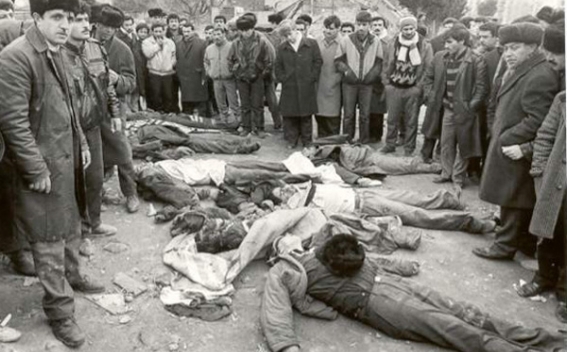It is hard to believe that thirty-four years had passed since the trajectory of my life and the lives of hundreds of thousands Armenians who were born in Azerbaijan veered into thousands of different directions. On February 27, 1988, and for several days after, the events that would later be named “The Sumgait Pogroms” took place in my home country, then Soviet Azerbaijan.
Anna Astvatsaturian Turcotte, author of “Nowhere, a Story of Exile,” human rights advocate, philanthropist, and founder of “astvatsaturian.org”, warns how Ethnic violence against Armenians will happen again unless…..

These pogroms targeted the Armenian minority population of the seaside town of Sumgait in Azerbaijan. Violent rioting mobs of ethnic Azerbaijanis stormed the streets and broke into homes of ethnic Armenian citizens of that peaceful city. These mobs attacked and killed Armenians both on the streets and in their homes, while the police observed and let the events unfold and medical personnel refused to assist the victims.

This was the start of the end of the Soviet Union. This was the end of my childhood. The events were triggered by a movement of liberation in the ancestral Armenian land of Nagorno-Karabakh, or Artsakh as Armenians call it.
In the 1920s this historic Armenian region was handed over to Azerbaijan by Joseph Stalin to instill constant tension in the region by his divide and conquer policy. In the beginning of 1988 Nagorno-Karabakh demanded to be reinstated back to Armenia, asserting self-determination by a referendum in accordance with the Soviet Constitution.
The Azerbaijani government did not tolerate this. Instead of peacefully negotiating with the Armenians of Nagorno-Karabakh, who made up close to 99% of its population, the government began an offensive, both militarily in Nagorno-Karabakh, and internally against the peaceful citizens of Azerbaijan of Armenian decent.
The propaganda machine began its skilled operation, fueling anger and hatred in the everyday Azerbaijanis toward their innocent Armenian neighbors. Soon after the Sumgait Pogroms more Armenian citizens suffered the results of this government-orchestrated hate, and in November 1988, the unfolded in a large city of Kirovabad.

Eventually, after months of riots, the violence hit home in January of 1990 in Baku, the capital city where I was born and lived; the city which prided itself on tolerance, multiculturalism, diversity and peace.
For a span of a week in this horrible January the Armenian community of Baku was raped, tortured and killed. Pregnant women were molested, little girls raped in front of their parents’ eyes, Christian crosses burned on their backs, elderly men and women robbed and set on fire.
These violent mobs travelled from home to home, attacking only Armenian households, as if someone was directing them. And indeed, someone was clearly directing them – these massacres were orchestrated by the Azerbaijani government.
Baku was no longer our home. This was a place we had to flee like hundreds of thousands of other Armenian citizens of Azerbaijan, lucky to be alive.
Some left bruised, beaten, with nothing, in the middle of the night in their nightgowns, boarding ships to nowhere. Others left hurriedly to distant places away from everything they knew and everyone they loved.
We lost our lives, our security, our belongings, our homes. The graves of my grandparents in Baku are no longer there because they were demolished, as were all of the Armenian cemeteries in Baku and the rest of Azerbaijan. The Armenian Church I treasured visiting as a child was set ablaze.
The first Artsakh War ended in a ceasefire in 1994. Although post ceasefire the Armenians of Artsakh gained full control of their borders, their own democratically-elected government and a Constitution, along with their own military and a functioning economy, for three decades they were isolated, unrecognized and blocked from the humanitarian aid and the human rights owed to them by humanity. And that wasn’t the end of their suffering.
When in 2020 Azerbaijan launched an offensive against Artsakh the world was reminded of anti-Armenianism, ethnic hatred of Armenians, and disregard to who was watching. The world was watching and doing nothing. Armenians were not wanted on their own soil and they were almost annihilated.
The rhetoric against innocent Armenians has tripled in the last three decades, especially after the latest war. Everyday Azerbaijanis are fed anti-Armenian propaganda by their government. There is a generation of Azerbaijani children that are taught by government-regulated schools that Armenians are monsters.
How does one live with a neighbour that is so prejudiced and violent toward Armenians, a country that so outrageously portrays itself as a beacon of tolerance and a model of multicultural, yet bombs Armenian churches and Armenian babies with F16s and weaponized drones? I don’t know. I don’t have any idea.
But one thing I learned from my family’s history with three instances of anti-Armenian violence (Armenian Genocide, the Baku massacres of 1918, and massacres at the end of the Soviet Union), is that we have to expect and be prepared that ethnic violence against Armenians will happen again.
Today I honour the victims of Sumgait, Kirovabad and Baku Pogroms. I bow my head to the defenders of the Homeland in the 2020 Artsakh War. All these deaths were unnecessary.
I honour the Armenian refugees from Azerbaijan and all they have been through. You are not forgotten and your pain and suffering will not be in vain. There is a generation of Artsakh babies born in Artsakh everyday. They still live in their, albeit smaller and broken, Homeland, and I will never stop working for their independence, peace and future.


